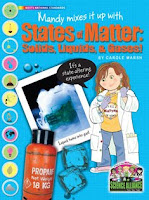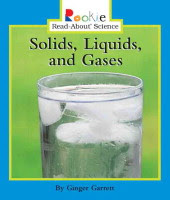Water is one of the most essential elements to our life. We need it to drink, bathe and keep our plants alive. In first grade, we will explore many of its properties: sinking and floating, what will dissolve in water, the water cycle, and much more. Although there is a lot of information to learn, we are lucky because there are a TON of great books, websites and experiments for us to use!
Books
A Drop of Water. By Gordon Morrison. Illus. by the Author. 2006. 32 p. Houghton Mifflin Books for Children, (0618585575). Gr. K-2.
A Drop of water is a great way to teach many different aspects of science. In this imaginative tale, we follow the trail of rainwater from the top of a mountain all of the way down to a stream. Personally, my favorite thing about this book is the imaginative pictures. It's a must have for any science lovers collection.
 Mr. Archimedes' Bath. By Pamela Allen. Illus. by the Author. 1994. 32p. Puffin, (9780140501629). Gr. 1-3
Mr. Archimedes' Bath. By Pamela Allen. Illus. by the Author. 1994. 32p. Puffin, (9780140501629). Gr. 1-3
This book is a humorous way to introduce water displacement to your first graders. If you love Who Sank the Boat?, then you will love this book by the same author.
The Magic School Bus At the Waterworks By Joanna Cole. Illus. by Bruce Degen. 1988. 40 p. Scholastic Paperback, (9780590403603). Gr. 1-3.
In this fun adventure, zany teacher Miss Frizzle takes her students on another field trip to explain the water cycle. Each student turns into water droplets, water vapor, clouds, and finally into rain. This book allows students to learn all about the stages of water while letting their imagination run wild.
 The Snowflake: A Water Cycle Story. By Neil Waldman. Illus. by the Author. 2003. 32 pg. Millbrook Press, (9780761323471). Gr. K- 2.
The Snowflake: A Water Cycle Story. By Neil Waldman. Illus. by the Author. 2003. 32 pg. Millbrook Press, (9780761323471). Gr. K- 2.
Take a journey through the different stages of the water cycle. This fantastical story begins with a single droplet of water and its journey throughout the year as rain, a pond, a snowflake and even to the faucet. A great way to show how we get the water we drink as well as the natural water cycle.
Who sank the boat?. By Pamela Allen. Illustrated by the Author. 1996. 32 p. Puffin, (9780698113732). Gr. K-2.
This book is a must-read when covering floating and sinking in your first grade classroom. Follow five animal friends as they each try to get into a boat. Do you know who sank the boat?
Honorable Mention:
Hot as an Ice Cube By Philip Balestrino. Illus. by Tomie de Paola. 1971. 33pg. Thomas Y. Crowell Company, (0690404158). Gr.1-4.
I give this book an honorable mention because, although it is filled with great facts about water and its different states (steam, vapor, ice, liquid), it may be very difficult for you to find. It has the amazing illustrations of the beloved artist, Tomie de Paola, of Strega Nona fame. The examples the book uses are very easy for children of the lower grade levels to understand and makes science fun and interesting. If you are able to get your hands on it, definitely check it out.
Web Sites
Changing State
This website allows students to see water changing from a solid to a liquid to a gas and back again at the quick click of a button. Instantly satisfying and clear to follow, this will be a great way to solidify their knowledge of what it takes to make water change its form. Be careful not to do the quiz, though; since the website is made in Europe, they measure temperature in Celsius and does not match with American standards.
Experiment: Turn Salt Water into Drinking Water
In this fun experiment, kids will see just how salt water can be turned into drinking water through evaporation and condensation. They will be able to see first hand how the water cycle works. A note to add: you may need to wait overnight for the experiment to be complete.
Flash Water Cycle
When teaching the water cycle to your first graders, be sure to have this website bookmarked. Its a great tool for quick reference and explanation for students who may need some visuals to understand these concepts. The graphics are eye catching and the information is basic enough to understand on all levels.
Float or Sink Game
The BBC has put up a short game perfect for first grade attention spans. Follow Digger and the Gang on their boat and discover what items they have will float and which will sink in water. Learners will discover why an item will sink or float. Perfect for indivualized computer time.
The Magic School Bus Wet All Over, A Complimenting Experiment
After reading The Magic School Bus' "Wet All Over" consider following up with the experiment on the preceding page. Here they learn about what happens to water when it is heated up and cooled in a neat hands-on-approach. Key terms they will learn are condensation and evaporation.
For Teachers
VA Standards of Learning
1.3 The student will investigate and understand how different common materials interact with water. Key concepts include:
a) some liquids will separate when mixed with water, but other will not;
b) some solids will dissolve in water, but others will not; and
c) some substances will dissolve more readily in hot water than in cold water
Background Information from the Curriculum Framework
Books
A Drop of Water. By Gordon Morrison. Illus. by the Author. 2006. 32 p. Houghton Mifflin Books for Children, (0618585575). Gr. K-2.
A Drop of water is a great way to teach many different aspects of science. In this imaginative tale, we follow the trail of rainwater from the top of a mountain all of the way down to a stream. Personally, my favorite thing about this book is the imaginative pictures. It's a must have for any science lovers collection.
 Mr. Archimedes' Bath. By Pamela Allen. Illus. by the Author. 1994. 32p. Puffin, (9780140501629). Gr. 1-3
Mr. Archimedes' Bath. By Pamela Allen. Illus. by the Author. 1994. 32p. Puffin, (9780140501629). Gr. 1-3This book is a humorous way to introduce water displacement to your first graders. If you love Who Sank the Boat?, then you will love this book by the same author.
The Magic School Bus At the Waterworks By Joanna Cole. Illus. by Bruce Degen. 1988. 40 p. Scholastic Paperback, (9780590403603). Gr. 1-3.
In this fun adventure, zany teacher Miss Frizzle takes her students on another field trip to explain the water cycle. Each student turns into water droplets, water vapor, clouds, and finally into rain. This book allows students to learn all about the stages of water while letting their imagination run wild.
 The Snowflake: A Water Cycle Story. By Neil Waldman. Illus. by the Author. 2003. 32 pg. Millbrook Press, (9780761323471). Gr. K- 2.
The Snowflake: A Water Cycle Story. By Neil Waldman. Illus. by the Author. 2003. 32 pg. Millbrook Press, (9780761323471). Gr. K- 2.Take a journey through the different stages of the water cycle. This fantastical story begins with a single droplet of water and its journey throughout the year as rain, a pond, a snowflake and even to the faucet. A great way to show how we get the water we drink as well as the natural water cycle.
Who sank the boat?. By Pamela Allen. Illustrated by the Author. 1996. 32 p. Puffin, (9780698113732). Gr. K-2.
This book is a must-read when covering floating and sinking in your first grade classroom. Follow five animal friends as they each try to get into a boat. Do you know who sank the boat?
Honorable Mention:
Hot as an Ice Cube By Philip Balestrino. Illus. by Tomie de Paola. 1971. 33pg. Thomas Y. Crowell Company, (0690404158). Gr.1-4.
I give this book an honorable mention because, although it is filled with great facts about water and its different states (steam, vapor, ice, liquid), it may be very difficult for you to find. It has the amazing illustrations of the beloved artist, Tomie de Paola, of Strega Nona fame. The examples the book uses are very easy for children of the lower grade levels to understand and makes science fun and interesting. If you are able to get your hands on it, definitely check it out.
Web Sites
Changing State
This website allows students to see water changing from a solid to a liquid to a gas and back again at the quick click of a button. Instantly satisfying and clear to follow, this will be a great way to solidify their knowledge of what it takes to make water change its form. Be careful not to do the quiz, though; since the website is made in Europe, they measure temperature in Celsius and does not match with American standards.
Experiment: Turn Salt Water into Drinking Water
In this fun experiment, kids will see just how salt water can be turned into drinking water through evaporation and condensation. They will be able to see first hand how the water cycle works. A note to add: you may need to wait overnight for the experiment to be complete.
Flash Water Cycle
When teaching the water cycle to your first graders, be sure to have this website bookmarked. Its a great tool for quick reference and explanation for students who may need some visuals to understand these concepts. The graphics are eye catching and the information is basic enough to understand on all levels.
Float or Sink Game
The BBC has put up a short game perfect for first grade attention spans. Follow Digger and the Gang on their boat and discover what items they have will float and which will sink in water. Learners will discover why an item will sink or float. Perfect for indivualized computer time.
The Magic School Bus Wet All Over, A Complimenting Experiment
After reading The Magic School Bus' "Wet All Over" consider following up with the experiment on the preceding page. Here they learn about what happens to water when it is heated up and cooled in a neat hands-on-approach. Key terms they will learn are condensation and evaporation.
For Teachers
VA Standards of Learning
1.3 The student will investigate and understand how different common materials interact with water. Key concepts include:
a) some liquids will separate when mixed with water, but other will not;
b) some solids will dissolve in water, but others will not; and
c) some substances will dissolve more readily in hot water than in cold water
Background Information from the Curriculum Framework
- Different types of materials act differently when mixed with water.
- Some liquids will mix with water, while others will not.
- Some solids will dissolve in water, while others will not.
- The temperature of the water affects how easily a substance will dissolve (to mix with a liquid so that the result is a liquid is the same throughout).























